This web page contains the logs of a fifteen-day sailing trip that I and my wife Alice took with S/Y Thetis in the Greek Aegean from the Samos Marina on the island of Samos to the Dodecanese (Arki, Levitha, Astypalea, Kalymnos, Leros, Lipsi, Agathonisi) and back again to Samos in Poseidonio this time. The logs are illustrated with maps and photographs, and also include some historical and geographical descriptions of the places visited as well as several links to other related web sites.
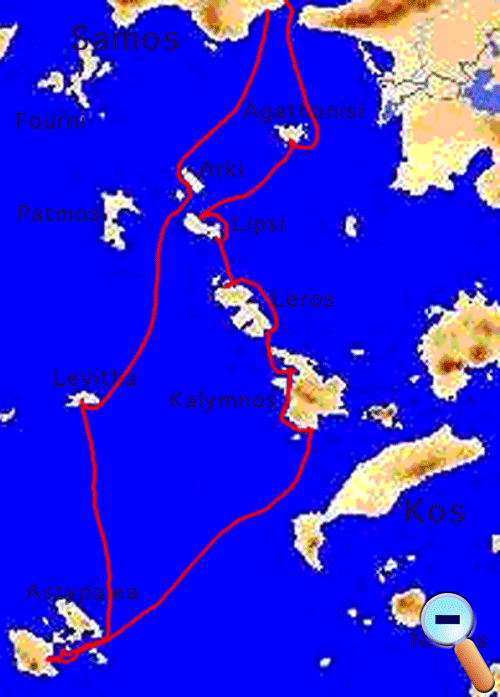
Tuesday July 4, 2000, Day 1
Alice and I met our faithful taxi driver, Dimitris, on the road up from the path of our Kalami house in Samos. We had already carted our clothes, food supplies, produce from our garden, etc. He drove us to the town of Vathi where we got some fresh bread and a case of bottled water, and then to the Pythagorio Marina. By the way, most taxis in Samos refuse to drive to the marina because of the bad road condition. Dimitris took us right up to Thetis who had been faithfully waiting for us. We stowed our clothes and provisions, removed the sail and winch covers, the spring lines, and were ready to go.
We cast off at 1020. As soon as we were outside the harbor we stopped. Thetis was covered with sand blown by the wind during this waiting period. Many bucketfulls of water later her deck and cockpit were once again livable. Now, at last, we were ready to go. The wind however, was a mere 8-11 knots NE so we had to motor to Arki, our destination. As usual, as we were approaching the small island Samiopoula, the wind direction changed to N but it was still 8-11 knots. Realizing that pure sailing was not in the cards, we put up the tent, unrolled the headsail, and motor-sailed.
We arrived at Porto Grosso or as the locals call it Glipapas (Γλύπαπας) [37° 22.4' N 026° 44.5' E], our favorite cove in Arki, at 1420 and after 23.4 M. We anchored without any problems and launched the zodiac which was lashed on top of the cabin. This allowed us, after a refreshing swim, to wash more thoroughly the deck and cockpit. Amazing how much sand Thetis had collected. The day was very nice but perversely it became rather windy after our arrival, with gusts reaching 23 knots NNW. The barometer was 1005 mB, temperature 29°C (84°F), relative humidity 40%. By the way, the Navtex was working and was forecasting light winds.
In the evening, Alice made pasta with a tomato and mushroom sauce. Very tasty. We ate it in the cockpit while admiring the new moon and the multitude of stars in the clear brilliant sky.
Wednesday July 5, 2000, Day 2
We slept very well. I woke up first at 0615 and made our coffee. We slowly prepared to depart for the small island of Levitha. We raised our anchor at 0815. The wind was from the NNW at 9-18 knots. I raised the main which was at its 2nd reef and motor sailed. After clearing Marathi island we opened the headsail and sailed rather slowly. I shook off the 2nd reef but left the sail at the 1st reef, afraid that we may get an increase of the wind. Still, after one hour of slow sailing I had to start the motor because we were not getting very far. We motor-sailed the rest of the way.
We arrived at Levitha (Λέβιθα) at 1310 having covered 27.6 M. My favorite N cove was occupied, there was room for only one boat, and we had to go to the E cove [37° 00.1' N 026° 28.1' E]. As I remembered from my last visit here, anchoring was kind of tricky. But Mr. Dimitris Kamposos, the head of the single family that resides in Levitha, had set 7 permanent moorings on concrete blocks, so we did not have to anchor after all. Nevertheless, not being sure of the reliability of the moorings I also took a line to the N shore. It turned out that this extra step was not necessary. After snorkeling I ascertained that the moorings were very secure.
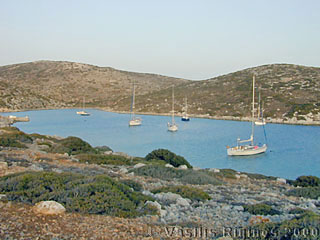
Later, while I was in the shower, Mr. Kamposos came and asked for 2,000 GRD for using his mooring. He was very pleased that I not only remembered him but also remembered his name. He was very apologetic about asking to be paid for the moorings but most boats use them without even visiting his wonderful small restaurant and he has to at least recover his costs for laying them.
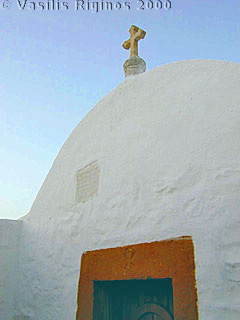
After our showers we went ashore and took a nice walk. Alice admired the stone walls and the fields that the Kamposos family keeps in such an immaculate condition. We were amazed at the sheer labor that must have been expended to clear the fields from the stones. We visited the lovely little chapel which like everything else on this small island was so well kept. According to its inscription the chapel was restored in 1858.
We ended up at the little restaurant in the Kamposos compound. We were served some delicious grilled fish along with potatoes freshly fried in olive oil and a salad garnished with their wonderful homemade cheese. While eating we met two couples from a Dutch boat who were also eating there. Nice people! At least 3 more boats were at the cove but these not only did not patronize these hard working people but, having refused to pay for the moorings, had anchored with some difficulty at the dubious bottom which consists of loose slate. I was shocked that anyone can be so cheap as to risk dragging to save 2,000 GRD (about $6).
After dinner we, the Dutch, Alice, and I, returned to our dinghies after getting lost a few times in the dark. It was a most pleasant day.
Thursday July 6, 2000, Day 3
I slept very well. I then started getting ready for our sail to Astypalea. The Navtex forecast called for low winds and very high temperatures in the 40°Cs (104°F) in Athens! First I untied the shore line and I was getting ready to raise the zodiac when the Dutch people from the S/Y Camelot whom we had met last night asked us to join them for a coffee. They were on their way to Bodrum where they were leaving the boat for a few months. They wanted information on Niseros. We gave them as much detail as we remembered from our last visit there. They had been earlier this spring to Tunisia and gave us a very favorable report. This is a place that I have been planning for several years now to visit.
By 0900, the zodiac was lashed on deck and we had cast off. I raised the main and shook off the 1st reef, left from yesterday. As predicted, there was not much of a wind and we motor-sailed for a while on a course of 179°. Later there was a better breeze and I opened the genoa and actually sailed for about ½ hr but the breeze did not last so we went back to motor-sailing. We motor-sailed all the way to Cape Exopetra. During this time I serviced the watermaker. First I cleaned its membrane with the alkaline solution, then I changed its pre-filter and re-primed it. While approaching the cape, I reduced the headsail expecting strong gusts. I was right. After we rounded the cape we did experience 28 knots with much higher gusts. We were reaching and Thetis was flying at 7.7 knots. It was a very exiting sail which continued all the way to the harbor.
We arrived in Skala, Astypalea (Αστυπάλαια) [36° 32.9' N 026° 21.3' E] at 1450. The distance from Levitha was 32.75 M. We anchored off without a problem. There were strong gusts and it was hot. The temperature inside the cabin was 36°C (97°F) while the barometer was slightly down from yesterday to 1004 mB. The AM radio was talking about the heat wave in Athens. We had a long swim and cooled ourselves. After the swim we did not feel too energetic and dozed off.
Later we were told that where we had anchored we may interfere with the maneuvers of the ferry boat due later in the evening. So we moved Thetis closer to the shore and re-anchored at 3.5 m. We went ashore for a walk but it was too hot and not very pleasant. Back on-board, Alice made a rice salad and cooled it in the fridge. We then ate it along with fresh bread we had bought ashore and a chilled white wine.
Friday July 7, 2000, Day 4
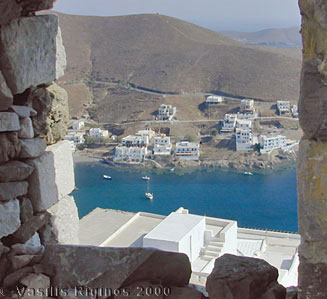
We slept rather well other than being woken up at 2 AM by the ferry but we went back to sleep after she left. First thing in the morning, even before coffee, we put up the tent as the sun was already burning. We then went ashore, and while it was relatively cool we climbed up to Chora and the Querini Castle. What I had not realized about the castle when I was here last time was that it was inhabited until the great earthquake of Santorini in 1956. At that time, there was some damage and the inhabitants were evacuated. Since then the buildings of the castle have steadily deteriorated as most of their floors are made of bamboo covered with plaster.
On the way down from the castle we tried to visit the church of Παναγία Πορταΐτισα (Panayia Portaitisa) but, just like on my last visit to the island, it was closed. So we continued down to the museum. It too was closed. It was being cleaned but we were told that it would open tomorrow. Hot and frustrated we sat at a cafe facing the waterfront for an iced tea. Having cooled off a little, we bought a few supplies and took the dinghy back to Thetis. We swam and I looked at the anchor. It was completely buried under the sand. The 30 m of scope for the 3.5 m depth was more than adequate for the expected increase of wind. After the swim we had lunch and siesta.
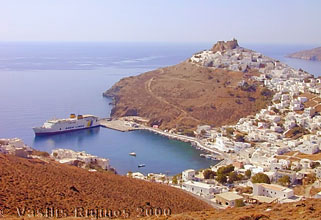
Later a British 32' singlehanded boat came and anchored smoothly near us without any fuss. As expected the wind increased in the evening while the Navtex started printing gale warnings for the Kafireas Strait, Sea of Ikaria, and the Kythera Sea. We also heard on the radio that a large fire was raging in Samos and a small earthquake shook Istanbul. A 53' sailboat with at least 10 people entered the harbor. Her headsail was torn to ribbons. They anchored with great difficulty uncomfortably close to Thetis, being very stingy with their chain. After I told them that a gale was due and advised them to let out more chain they let out a few more meters. I think that charter companies should give anchoring lessons before they charter their boats.
We then went ashore and climbed up to Chora. I wanted to eat in a restaurant I had noticed on my last visit with the enticing sign: “Παραδοσιακές Λιχουδιές” (Traditional Morsels). We sat down although the wind was fierce. They only had some greasy cheese fritters. So much for that. We walked down to Skala and had some grilled chicken for dinner.
When we returned to Thetis it was very gusty. The barometer had fallen further to 1002 mB but the temperature was only 33°C while the relative humidity was a mere 34%. Not uncomfortable.
Saturday July 8, 2000, Day 5
This was a busy day. We did not put up the tent due to the violent wind. We went ashore and visited the tiny museum which is right next to the kiosk which, although it is made of concrete and it looks unlike any other kiosk, nevertheless has a sign proclaiming it: Περίπτερον (Peripteron - Kiosk). In the museum they have several nice and legible inscriptions as well as some good photographs of the Roman mosaics found near Maltezana and a set of classical coins from Chios.
We then argued whether to rent a car or a motor scooter. I pointed out that a scooter would be cheaper and cooler in this very hot day. Alice pointed out that a car would be less dangerous and would keep the dust out and will provide a shade in this very hot day. Alice prevailed! We rented a Suzuki Samurai 4-wheel drive for 18,000 GRD from the Manos-Lakis, right at the waterfront. We then did some shopping, ferried the supplies to Thetis, got our bathing suits, camera, and a picnic lunch.
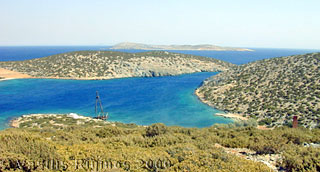
We drove E, past Maltezana where the paved road ended. The whole island is very dry — no trees. There are lovely and deserted beaches everywhere and this was July! The road was extremely dusty so after all I had to agree that a “jeep” was a better choice than a motor scooter. We drove past Agriolithi (Αγριολίθι) and up the mountain N and then down again to Mesa Vathi (Μέσα Βαθύ). This is a very beautiful inland sea and a terrific anchorage completely protected from the meltemi but it could be very shallow. However, we could not find a single shady spot where we could stop for our picnic lunch. Instead, and just as well, we sat at the only restaurant/pension the Galini (Γαλήνη). The small quay was full of fishing boats from Kalymnos. As expected the grilled fish that we had was very fresh and delicious. Along with a salad and some cold beer and the shade, it was just the right thing during these hot hours.
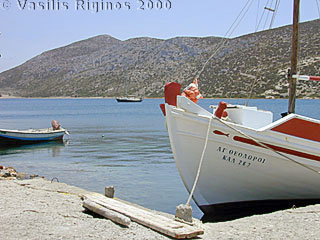
Fishing Caïque |
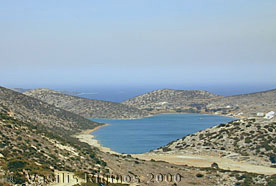
From the East |
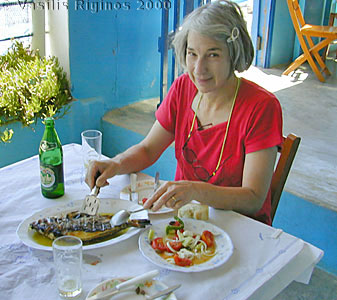
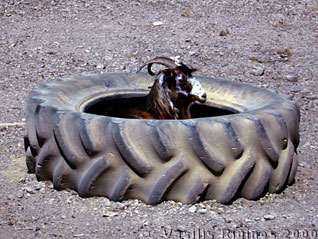 We drove back stopping to take pictures of the scenery and goat sheds. By the time we returned to Thetis it was already 4 PM. The wind was down somewhat and we put up the tent. We swam and rested. Later we transferred a can of fuel into the main tank and, taking advantage of the rented car, we drove to a gas station and refilled it with 22.5 L. We then drove W past Livadhia (Λιβάδια), on the dirt road to Ayios Konstantinos ('Αγιος Κωνσταντίνος). The scenery was very desolate, almost a desert. When we returned in Skala we had a very welcomed ouzo along with excellent grilled octopus at the Steki. Our server was a Scottish lady! This place looked very interesting for dinner but Alice had already made a tuna pasta that was waiting for us. A Turkish gulet (large wooden two masted boat pretending to be a sail boat usually full of rowdy passengers) came into the harbor but fortunately anchored some distance from Thetis.
We drove back stopping to take pictures of the scenery and goat sheds. By the time we returned to Thetis it was already 4 PM. The wind was down somewhat and we put up the tent. We swam and rested. Later we transferred a can of fuel into the main tank and, taking advantage of the rented car, we drove to a gas station and refilled it with 22.5 L. We then drove W past Livadhia (Λιβάδια), on the dirt road to Ayios Konstantinos ('Αγιος Κωνσταντίνος). The scenery was very desolate, almost a desert. When we returned in Skala we had a very welcomed ouzo along with excellent grilled octopus at the Steki. Our server was a Scottish lady! This place looked very interesting for dinner but Alice had already made a tuna pasta that was waiting for us. A Turkish gulet (large wooden two masted boat pretending to be a sail boat usually full of rowdy passengers) came into the harbor but fortunately anchored some distance from Thetis.
Sunday July 9, 2000, Day 6
Since we had the use of the car until late morning we wanted to make the most of it, so we got up early and drove past Chora on another rough dirt road to the Castle of St. John (Κάστρο του Αγίου Ιωάννη) on the NW shore of the island. Amazingly dry terrain, desert, more desert than the desert of Arizona where at least the saguaros provide some green, here there is only brown scrub. The road went up by the highest point, Vigla (Βίγλα). The road map was not very accurate on the details and the tourist guide’s description of a “lush valley” was really a dry river bank with a few anemic oleanders. But it was an interesting ride anyway.
We got back to Skala before 10 AM but the next anxious customers for the car were already waiting at the rental office. We went on board Thetis and taking advantage of the good signal here sent a few e-mails. At 1045 we raised our anchor and motored, towing the zodiac, the 3.5 M to Maltezana (Μαλτεζάνα) [36° 34.5' N 026° 23.2' E]. The wind was way down and the sea very calm. We anchored at 4 m over the sand at 1120. This motoring at least gave us the opportunity to charge our batteries and run the watermaker.
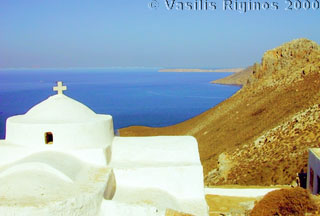
The day got rather hot, 32°C (90°F), relative humidity 40% and the barometer still down at 1002 mB, and we kept jumping into the sea to cool off. This is a pleasant anchorage and the sea was very clear. The only cloud in our horizon was the news from the AM radio about the fire in Samos which was still raging. Alice made a potato salad which we ate under the tent in the cockpit.
In the evening, after cleaning the boat, we went ashore and saw the very whimsical 6c AD mosaics at the Byzantine bath of Talenda. We bought some provisions, mostly bottled water, and started on our way back to Thetis. At the pier we met Antonis, the owner of the trechantiri Θύελα (Thiela - Storm) which was in fairly good condition and on sale. She was built in Skiathos in the 70’s. Antonis knew my brother Nikos whom he had met here last year.
Back on board, we had an ouzo and then pasta with hot tomato sauce. The humidity increased dramatically to over 60%.
Monday July 10, 2000, Day 7
We woke up at 0500 and prepared for our departure from Astypalea, our destination was the island of Kalymnos. We, lashed the dinghy on deck, raised the anchor, and were on our way by 0620. There was hardly any wind but the sea had some swell. We motored. At least we were recharging our batteries and replenishing our fresh water by running the watermaker. We put up the tent. Later there was a 5-12 knots N breeze and we opened all of the genoa and motor-sailed for about 10 M after which the wind died out. We motored until we were about 4 M from Kalymnos when the wind increased to 12 knots and we were blissfully able to turn off the engine, even for such a short distance.
We arrived at Vlichádia, Kalymnos (Βλυχάδια, Κάλυμνος) [36° 55.8' N 026° 57.9' E] at 1210 after 35.6 M. It is a beautiful cove. We anchored at 6 m on the E side of the cove and I took a line ashore and tied it on a rock. But after snorkeling and inspecting the anchor I realized that it was not well set in the soft mud. We re-anchored closer to the NW at 4 m. The bottom here is loose sand with clusters of thick weed. But this time we let out more than 35 m of chain and the anchor set well. There were strong gusts from the NW, the N, and the NE. It was still hot, 32°C (90°F), relative humidity 23% and the barometer slightly up to 1004 mB.
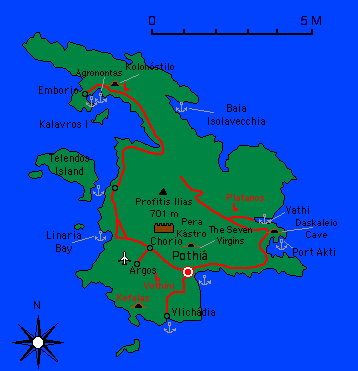
Kalymnos with an area of 109 km² is the home of the most well known sponge divers in Greece. In years past, they had a large fleet of boats which left the island every year after Easter and went to the shore of N. Africa for several months. The hard life of the sponge divers is well described in the wonderful stories of the Modern Greek writer Yannis Maglis. As the sponge trade diminished, taken over by plastic sponges, the island went into a decline and many of its inhabitants migrated to Tarpon Springs in Florida, USA and later to Australia. Still, there are several sponge boats based in Kalymnos and the Kalymniots are not only terrific divers but all around superb seamen of great daring. Not too long ago, a visitor to the island could not fail but notice the large number of crippled men. They were victims of the bends, the embolism brought on by un-dissolved nitrogen bubbles in the blood, that is caused by inadequate decompression after a long dive.
According to mythology, Kalymnos was a son of Ouranos (Sky) and Rhea (Earth). His father flung him into the sea but he landed on his mother’s bosom and rose from the sea to become a group of islands named Kalydnai. Kalydnai are mentioned by Homer as participating in the Trojan War but it was not until the 4th century BC that the largest of the group became known as Kalymnos. A Neolithic settlement has been found near Vothíni and a Neolithic shrine to Zeus in the Kefalos Cave on the S side of the island. The island was first colonized by Mycenaeans from Argos who were followed by the Dorians. During the Persian Wars it was conquered by the Persian ally Artemisia, the Carian queen of Halicarnassus (modern Bodrum). Following the Persian defeat Kalymnos joined the Delian league and allied with Athens.
During the Middle ages Kalymnos was part of the Byzantine Empire until the 11th century AD when it was invaded by the Seljuk Turks who killed almost all of its inhabitants. The few survivors retreated inland to the Pera Kástro (far Castle) which became the island’s medieval capital. After the Fourth Crusade, the Vinioli of Genoa took over the island but they sold it to the Knights of St. John who further fortified the old castle. They lasted until 1522 when they left to help their brothers in Rhodes who were under siege. After, Rhodes fell, the Knights moved to Malta and the Ottomans took over both Kalymnos and Rhodes. In 1912 the Italians bought Kalymnos along with the rest of the Dodecanese from the Turks. During the fascist period, before the World War II, the Italian fascists tried to convert the islanders to Catholicism and closed down the Greek schools. They were met with fierce opposition. After the war, in 1947 Kalymnos was united with Greece. To this day Italinas are disliked in Kalymnos.
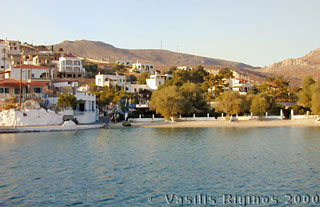
Two day-trip boats came full of noisy bathers but fortunately by 3 PM they were gone. Also, at the entrance to the cove a diving boat full of divers was moored but again by late afternoon she was gone also.
Later in the evening we went ashore and after a walk we gravitated to the Paradisos (Paradise) restaurant where we first had an ouzo with octopus (very good) which was followed by grilled chicken shish kebob and a “Kalymnos” salad, tomatoes, cucumbers, peppers, and onions over a bed of hard tack (παξιμάδι - paximadi). All very tasty. They also had a very friendly African Gray parrot.
During the night a sea breeze came from the S. As a result Thetis drifted towards the shore. Not dangerously but enough for an uneasy sleep.
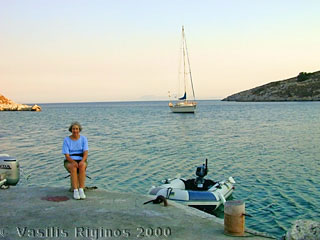
Tuesday July 11, 2000, Day 8
During the night, just to increase the worry created by the S breeze, a small ugly little fishing boat named Nikos came and anchored with a very short scope right next to Thetis. As Thetis drifted with the changing breeze we almost collided. The fisherman re-anchored, not too far. Just to add to the over all discomfort there were some rather vicious mosquitoes flying about. At 2 AM the fishing boat left “Πάω να καλάρω τα παραγάδια” (“I am going to set the fishing hooks”) explained the fisherman. An hour later he was back, again uncomfortably close to Thetis. Finally he left around 6 AM to raise his hooks.
After we got up, I set the second anchor to prevent large swings of Thetis and a repeat of last night. There were several elderly ladies having an early hour swim. We then went ashore and caught, at 0815 (it was scheduled for 0830), the bus to Pothiá (Ποθιά). A number of the swimming ladies were in the bus and were very helpful. It turns out that one needs to have tickets for the bus. However, the tickets are only sold in Pothiá. If you are in Vlichádia it is catch 22! One of the ladies did offer us her extra tickets but the driver agreed to give us a ride “on credit.” We could give him the tickets after purchasing them at our destination.
The island of Kalymnos is dry (but not as dry as Astypalea) and sparsely cultivated. Its main city and harbor, Pothiá is sprawling with ugly cement-box new houses many of them with their re-enforcement rods un-aesthetically sticking out from their roofs. After we arrived at the end of the line and bought the owed tickets, we walked along the harbor. It is large and attractive with plenty of room for yachts and it is well protected from the waves. There is no electricity or water available, however. On the other hand, there are no blinding lights to keep one from sleeping at night when moored there either. The rest of the town is not very attractive despite some large and imposing Italian buildings.
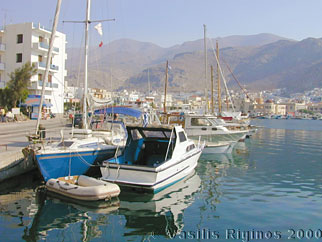
Pothiá the Harbor of Kalymnos |
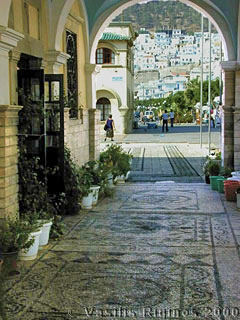
The Nautical Museum Entrance |
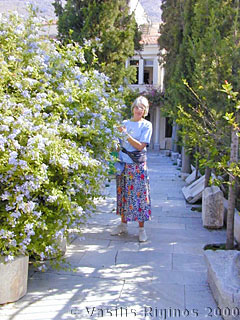
We bought a Greek newspaper and sat at a cafe to read about the fire in Samos. We ordered an orange juice and the waiter brought us some cold water “from a spring - good for your health.” The horrible fire in Samos was still raging now for its 6th day. Vast areas had been devastated including the magnificent pine forest at Mt. Ambelos. This fire had cast a bad feeling over our otherwise wonderful cruise. Both Turgut and Manos had called us wearied about our safety thinking that we were in Samos.
We walked to the Archaelogical Museum. On the way we asked direction from two policemen, a man and a woman, who informed us that there is no Archaeological museum in Kalymnos. We persisted and after a while we did find the non-existing museum. It is housed in the Vouvalis mansion. Nikos Vouvalis was Kalymnos’ wealthiest man around the beginning of the 20th century. He had made his enormous fortune in sponges, the island’s main product. He had no children and his fortune passed to his wife 20 years his junior. After her death, all their property was donated to the community. It is an imposing mansion with a lovely garden. Archaeology is represented in a large, dusty and not particularly interesting room. The rest of the exhibit is about Mr. Vouvalis. In his office you see his checkbook (ca 1980’s), ledgers, correspondence around the world—he had branches everywhere. The lavish dining room has all the Victorian elements including the silver toast rack. The main character of Yiannis Maglis’ wonderful novel Ο Άρχοντας - The Archon is modeled after Vouvalis.
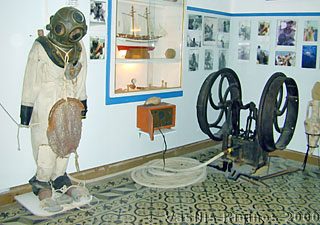
After the museum we walked back towards the waterfront. Contrary to my first impression, there are a few graceful old houses but they are eclipsed by the modern box variety ones. We went to the Nautical Museum. It has a very interesting exhibit on the history of sponge diving. It is an amazing story of wealth, daring, and human misery. Sponge diving was the major occupation in Kalymnos (as well as Simi and Halki) until recently when natural sponges were replaced by plastic ones. The men would leave the island on small caïques in the Spring and would return in late Autumn. They ranged all along the African coast of the Mediterranean. Many of the divers did not return or returned as cripples. Thousands over the years. Knowledge of the bends did not exist and the treatment was primitive at best. The victim was buried up to his neck in the hot sand. After a few days some survived, others did not.
Next to the Nautical Museum is the Folklore Museum operated by the local Greek Ladies Club (Λύκιο Ελληνίδων - Lykio Ellinidon). It shows several local costumes and embroideries. They also sell some contemporary stuff. Alice bought some embroideries and I a book on the history of sponge diving: Bitter Sea by Faith Warn. Outside the museum we saw a grocery store with some baskets for sale. We bought one. Before it was given to us, the proprietor took it to the sea and wetted it. This makes it last longer he explained.
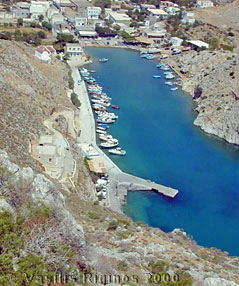
We flagged a taxi and asked the driver to first take us to Vathi (Βαθύ) and then back to Vlichádia. The driver had returned from Australia where he had immigrated when he was 17. He was very pleasant and talkative. He told us about sponge diving in Kalymnos, pearl cultivation in Australia, life back home in the island, and many other things. We stopped at the top of Vathi and took some pictures. This is one of the best anchorages in the island but it is often crowded. I was told by the Kalymnian fishermen that I had met in Astypalea that one should never arrive at Vathi after the early afternoon. From the top of the hill it does look wonderful. There were many yachts but there still was some room. We then drove back to Vlichádia.
After we returned to Thetis we swam, had some lunch, and another swim. Still hot 32°C (90°F). After resting we went again ashore in the evening and visited the nearby Sea World Museum. This is a private museum created by the Valsamides brothers who are local divers. They have a very extensive and interesting collection of sea-shells. The rest of the exhibits are rather idiorythmic but fun: tools, old diving gear, weapons and bombs found under water, dried fishes and other sea creatures, along with a shallow pool representing the Dodecanese. We met Stavros Valsamides who is an accomplished diver and a very colorful character. Despite two heart by-pass operations he still dives and will take you for a diving tour. He speaks of caves with live seals and other fascinating things. I wish we had more time to go diving with him. Maybe another year…
We had an ouzo ashore and then back on board for pasta alla puttanesca.
Wednesday July 12, 2000, Day 9
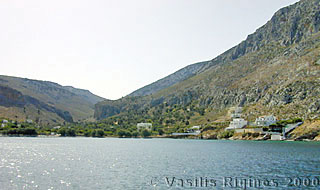
In the morning, we pulled up both anchors and departed from Vlichádia at 0820. The wind was from the N a light 4-16 knots but nevertheless there was some swell. We motored along the W side of the island passing the channel between Kalymnos and Telendos. At the NW side, we entered the cove of Agronontas [37° 01' N 026° 57.9' E] which looks as a very attractive and well protected anchorage. We must come again! Then we checked the small town of Emborios [37° 02.7' N 026° 55.7' E]. The water here was not very appealing, it was quite murky most likely by the run-off from the nearby fish farms. Other than that, and the warning of the pilot book by Heikell that the holding is bad, the small town is attractive. There are several laid mooring that one could use, I suppose.
We continued motoring N to our destination the cove of Xerocambos (Ξηρόκαμπος) in the S of the island of Leros (Λέρος). We arrived in Xerocambos [37° 06.5' N 026° 52.3' E] at 1205. The distance from Vlichádia, with all the detours, was 18.9 M. Now the last time that we had been here, back in 1989, we had dragged our anchor so we were somewhat apprehensive. We found a clear patch of sand and dropped the anchor. It caught. I verified it by snorkeling. The sand here is hard with large patches of weed where an anchor may not penetrate.
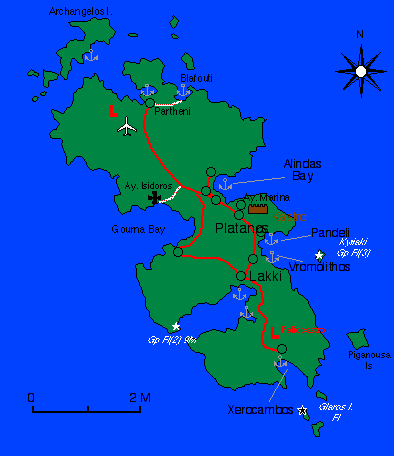
Leros is a fairly low island of 53 km² and 8,000 inhabitants. It has many beautiful beaches and unspoiled villages and a wildly serrated coastline. Poor Leros, she has been downgraded for centuries. First the name which means “dirty” and “malodorous.” Then the large psychiatric hospitals, then the terrible legacy of the very destructive “Battle of Leros” during the WW II when she was bombarded for over 50 days and finally invaded by the Germans in a dramatic landing. During the days of the junta Leros was a place of exile and torture housing the infamous prison of Partheni. Finally, in more recent times, it has received some very bad press concerning the conditions in the remaining psychiatric hospital.
The island has been inhabited since prehistoric times. The first inhabitants were most likely Pelasgians, Lelekes, and Karians. They were followed by the Dorians who were succeeded by the Ionians from Miletus. Homer mentions Leros, together with Kalymnos, as the “Kalydian islands” and included them in his Catalogue of Ships in the Iliad.
Leros was the sacred island of Artemis. According to the Mythology, after the death of the hero Meleager (the killer of the Calydonian Boar), Artemis took pity on the sorrow of his sisters and turned them into guinea fowl and put them in her temple at Partheni.
Leros was occupied by the Persians who departed after their defeat at Salamis. During the Peloponnesian War, Leros sided with Sparta. In the Roman times, Leros and the surrounding islands were dominated by pirates. During the Byzantine era the island was part of the Samos prefecture. In 1316 AD Leros was taken by the Knights of St. John and was governed by the Duke of Naxos. From 1455 until 1527 the island was ravaged by pirates until finally it was occupied in 1527 by the Ottomans. In 1821, Leros took part in the war of independence and became part of the new Greek state. In 1912, along with the rest of the Dodecanese, Leros fell under the Italians who held it until 1943. During this period the Italians built the town of Lakki. They were succeeded by the allied forces, mostly British. The island was then invaded by a large force of German paratroopers and many buildings were destroyed during the “Βattle of Leros” (November 12-16, 1943). The Germans held Leros until the end World War II, when it was united with the rest of Greece in 1948.
Music-making is a long tradition in Leros. Even today one can encounter live music here with traditional instruments such as: santouri (dulcimer), tsanbouna (bagpipes), lagouto (lute), and the lyra (a small violin-like instrument). The traditional songs and dances are: the Issos Lerikos, the Sousta, the Stavrotos, the Passoumaki, and the “Dance of the broom.”
All would had been well had we not received a phone call on the GSM phone from Maritsa the wife of our beloved Telemachos, the caretaker of our property in Kalami, Samos. She called from Athens. It seems that Telemachos had a stroke a few days ago and they flew him to a hospital in Athens. She told us that he is not in danger but they are expecting the results of several tests to evaluate his condition. We all love Telemachos who not only has been taking care of the property for over 20 years, but has become a member of our family. This news had really upset us. We just hope that his condition is not serious.
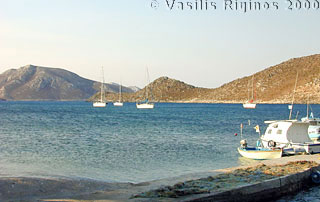
It was hot, 36°C (97°F), but the barometer had risen somewhat to 1007 mB but it was dry 25% relative humidity. The wind kept changing direction but was not too strong. While we were eating lunch in the cockpit we were entertained by a group of people playing live music under a tree. One of them played the Cretan instrument lira (λύρα). It is fairly quiet here except for an excavator operating at the NW of the cove. Fortunately in the evening they stopped.
In the evening we called Maritsa at the hospital. She was very distraught and was not sure what the situation with Telemachos really was. She asked if we personally knew of any doctor working at the KAT hospital. We did not. But I called my brothers Nikos and Byron to see if they did or could locate someone who did. We were all hoping.
After showers and an ouzo aboard we went ashore and had dinner at the Kyma (Κύμα) restaurant and also gathered information. It seemed that we were located about 3-4 km from the main harbor Lakki (Λακκί) which is served by a bus. We will walk there early tomorrow morning. Our meal consisting of grilled octopus and grilled chicken was not very remarkable.
Thursday July 13, 2000, Day 10
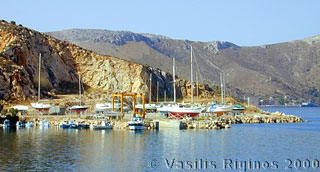
We walked for about 50 minutes to Lakki. I wanted to explore the possibility of wintering Thetis here. I had heard good reports about a new shipyard. At the SE outskirts of Lakki we did see a shipyard. We went in and met the proprietor of the Evros Shipyard Mr. Kostas Kalatzopoulos. His prices are very reasonable: 80,000 GRD for the travel-lift (in and out) then 35,000 GRD per month. We then walked to the Agmar Marina at the other NW end of the town. Here we met with one of the directors Mr. Vasilis Paraponiaris. The marina provides water and electricity, washing machines, showers etc. Very nice. Agmar’s shipyard facilities are at Partheni, on the N of Leros. Their prices are also reasonable. For a 37' sailboat a comprehensive 400,000 GRD which includes yearly storage plus two launching, with the travel-lift. Agmar also operates a chandlery.
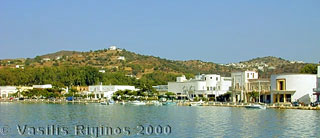
We walked around town and bought some supplies. There is a wonderful fruit market. The town is indeed surrealistic with its empty wide avenues and run down pre WW II Italian buildings. After our shopping we took a taxi back to Xerocambos.
We had lunch on Thetis. The wind changed to SW (Γαρμπής - Garbis), with strong gusts, and we drifted towards the shore in shallower waters of 2.5 m depth. I was a little concerned but not alarmed because the anchor was holding (checked it again with the mask).
We talked on the GSM phone with Maritsa. Telemachos was better. It appeared that his stroke was a mild one. We were still hoping…
Before dusk, concerned about the SW wind and just in case, I set the second anchor. Now we should be able to sleep without any worries. We made a rice pilaf for supper.
Friday July 14, 2000, Day 11
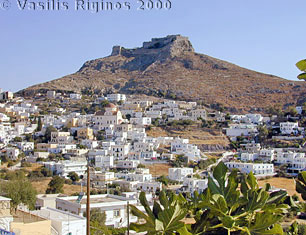
During the night the wind direction changed back to NW. The Navtex predicted that the wind will increase to near gale strength.
We took the 8:00 AM bus to Lakki and rented a motor scooter for 2,500 GRD/day. The man from whom we rented the scooter told us about the “battle of Leros” in 1943 when the Germans invaded the island and the terrible bombing of the harbor that preceded the invasion.
We drove to the town of Platanos and then to Ayias Annas where we visited the Archaeological Museum. The museum has very attractive cases, well labeled and lit, but the exhibits are not major. On the way, we passed Pandeli which looked like a pleasant anchorage providing some protection from the meltemi. We then drove to Alindas (Άλινδας), on the E side of the island, and visited the Ethnological Museum housed in the Belini Tower, a castle like mansion built by Mr. Belini, a wealthy Lerian who lived in Egypt. The whole of the second floor of the museum is dedicated to the “Βattle of Leros” and the sinking of the Greek navy ship Olga. All very interesting.
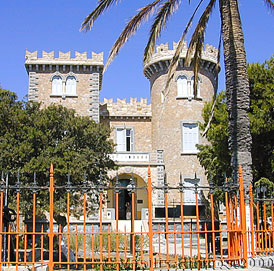
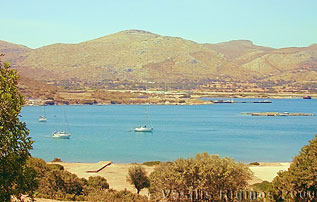
We continued our drive through the island all the way to Partheni (Παρθένι) where we visited the Agmar Shipyard. We met with its director Angelos Gaitanidis; both he and the facility made a good impression on us. We also talked to several boat owners who confirmed that the engine, machine shop and mast repairs are very good.
We drove to the nearby chapel of Ayia Matrona, over the cove of Kioura, that has modern frescoes painted by the political prisoners held here at the bleak military camp during the days of the junta (1967-72). In general, Partheni, although a very good anchorage, can be depressing because of its dark history.
On our way back we stopped at the site of the Temple of Artemis which is just SW of the airport. Unfortunately not very much remains to be seen.
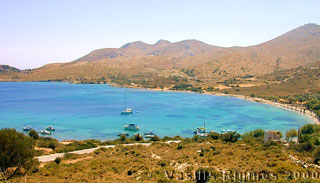
After Partheni, we drove E to Blafouti (Μπλαφούτι) or Plakoudi according to Heikell. It looked like a very pleasant anchorage but I was not sure of how well it is protected from the meltemi. We then returned to Xerocambos taking the W drive along the large bay of Gourna which is less attractive than the E bays. Also, Gourna is exposed to the meltemi. By now, the wind was howling. We had a salad and a beer at the Kyma and then went aboard Thetis to rest.
In the afternoon, taking advantage of the scooter, we drove and then climbed to the “Ancient Fort” or Paliokastro overlooking Xerocambos. The fort was not much to see but the view was well worth the climb. We then visited the small chapel of Panayia Kavoradema which is about 1 km E of Xerocambos. The chapel is built in a cave just at the water’s edge. It is very picturesque and I am sorry that I did not take a picture. Next time.
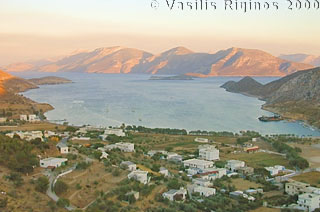
Saturday July 15, 2000, Day 12
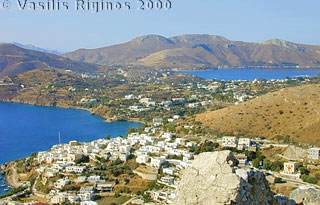
In the morning, we drove the motor scooter to Kastro. It is a wonderful Byzantine castle later used by the Knights of St. John. The view from the castle is superb: you can see both Pendeli, Vromolithos (another promising cove for anchoring), and Lakki. Inside the castle there is a jewel of a tiny Ecclesiastical Museum set by the Bishop Nectarios who is the Bishop of Leros, Kalymnos, and Astypalea and, like all bishops of the Dodecanese, he reports to the Patriarch in Istanbul rather then to the Archbishop in Athens. Also, inside the castle there is the small church of Panayia Kyra, built on 1300 AD, which has several nice frescoes.
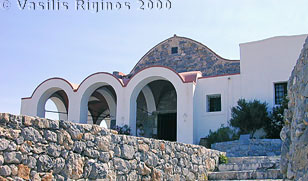
After the visit to the castle we drove the scooter back to Lakki and returned it. We then bought some more provisions and then took a taxi to Xerocambos and Thetis and started getting ready for departing.
By the time we had raised both anchors and were under way it was 1215. The wind was a light 4-8 knots from the WSW. No chance of sailing. We motored N along the E side of Leros while enjoying our lunch in the cockpit.
At 1350 we entered the cove of Blafouti [37° 11.49' N 026° 49.2' E], just to check it out. It is indeed very attractive and well protected from both the NW meltemi and the southern winds. We did not stay but proceeded to Lipsi, the next island N.
We arrived at Papandria [37° 16.8' N 026° 46.2' E], the southernmost cove in Lipsi, at 1500 having covered 14.85 M from Xerocambos. We anchored without any problem in our familiar spot behind the little island of Lira.
In the evening we went ashore and walked to town. First we had an ouzo with grilled octopus at the harbor and then a very nice grilled fish at the Theologos restaurant. During our meal there was a power outage so it was rather romantic. Well fed, we walked back to Katsadia.
During the night the SW wind increased and an uncomfortable, but not dangerous, swell entered the cove.
Sunday July 16, 2000, Day 13
Because of the unpleasant swell coupled with the Navtex forecast of more SW wind, we decided to try another cove. By 0855 our anchor was up and we were motoring (the wind was a very light 4-6 knots WSW) along the E side of Lipsi. At 1010, after 6.7 M, we arrived at Platys Yialos (Πλατύς Γιαλός) [37° 18.8' N 026° 44.5' E]. This is a cove very well protected from the S and SW winds and partially protected from the NW meltemi. We anchored at 5.5 m over sand, very good holding. It is a very attractive cove with one small taverna.
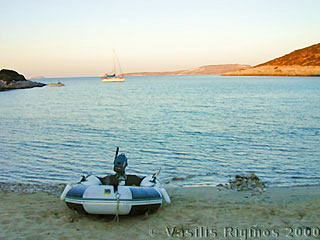
All day bathers kept arriving and leaving on scooters and a bus. There were very few cars. The water is crystal clear and the place fairly quiet. The temperature was a reasonable 27°C (81°F), the relative humidity 69% and the barometer was up to 1009 mB. The sea here was mirror calm. Altogether a delightful place.
By the early evening all the bathers had left and we had the cove all to ourselves. We went ashore and checked the taverna but it closes after sunset. We took a nice long walk. When we were returning it was dusk and the full moon was rising. Thetis was reflected in the silver water. It was glorious sight.
Alice made a linguini with a sauce of three different-colored peppers. It was delicious along with a chilled Robola white wine. The night was very pleasant and peaceful.
Monday July 17, 2000, Day 14
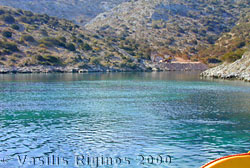
We raised our anchor at 0830 and exited the cove of Platys Yialos. There was hardly any wind but the forecast called for an increase of the NW later in the day. We motored N along the coast of Lipsi for 3 M to its NW extreme, the cove of Moschatou (Μοσχάτου) [37° 19.1' N 026° 43.4' E]. This is a very well protected anchorage with 3 fjords but unfortunately it is ruined by a fish farm that takes over the N fjord. Maybe they will put one on the S fjord to complete the detraction. For the time being the S fjord is a good refuge in case of bad weather. But there was some large road construction equipment which may not bode well for the future.
We did not stay at Moschatou, but continued motoring to Agathonisi (Αγαθονήσι) where we arrived at 1130 having traveled 18.2 M from Platys Yialos, Lipsi. We anchored at the W cove [37° 27.3' N 026° 57.8' E] and then took a line ashore and secured it to a rock. Unfortunately though, our anchor dragged and we started drifting towards the rocks. So, I was forced to take the 2nd anchor with the dinghy and set it at 6 m. This time it held well. This was good because in the afternoon we experienced several gusts at first from the W and later from the NW.
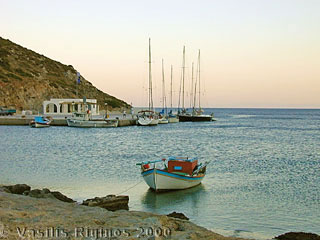
This is a very pleasant cove. Last year it was deserted, this year there is a pile of building material. This does not bode well. In the mean-time, we had a very quiet and pleasant afternoon.
In the evening, the wind increased and there were some very strong gusts. We took the zodiac and went to the harbor, less than 1 M away. We had some excellent grilled barbounia (red mullets) at our friend’s the Glaros restaurant. He reassured us. No, they are not building a new road to our cove, just a private house some where further and the caïque had just unloaded the material there. There is now also a new fuel pump at the harbor (but not a hose long enough to fuel a boat directly). Also this year there was good GSM signal.
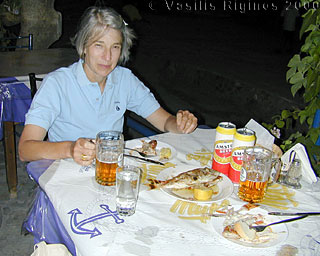
Tuesday July 18, 2000, Day 15
In the morning we started getting ready to leave Agatothonisi for Samos. We untied the shore line, raised, the second anchor, raised and secured the zodiac on the deck, and then raised the main anchor. We left at 0820. Outside the cove and at the entrance of the bay the wind was violent, gusting to 40 knots. But further out the wind was a more reasonable 19-30 knots NNW. We raised the main, no reefs, and sailed SE. After rounding the island, the wind and the chop were totally against our direction which was from the N. I tacked to the E and opened the headsail by 50%. After several tacks we made slow progress towards Samos but avoided the spray and the banging that we would had to endure had we motored totally against the weather.
By 1300 we were near Pythagorio, our intended destination. At that time, we changed our minds and decided to go to Poseidonio instead and avoid the heat of the harbor, so we kept on sailing. We were overtaken by several large cruise ships heading for the Mycale Channel. We also had to change our course to avoid a large inflatable tending a diver right in the middle of the channel. We arrived in Poseidonio [37° 42.7' N 27° 03.4' E] at 1415. With all the tacks we had covered a distance of 28.6 M (the direct distance is about 15). We dropped our main CQR anchor on a sandy spot at 4 m and let out 40 m of chain.
I snorkeled to cool off and to check the anchor. It was well set. We then put up the tent and had lunch after which we both fell asleep.
In the evening we set the second anchor with 80 m scope on another sandy spot. We then went ashore. First we visited our friend Mr. Nikos Karapanayiotis who in previous years had kept an eye on Thetis. Then we had dinner at the Dionyssos restaurant. We had a very good chicken roasted on the spit. We also called our friendly taxi driver, Dimitris, and made arrangements to pick us up at 9 in the morning. The GSM signal was fine where Thetis was anchored but there was no signal while we were ashore.
This is the end of the second leg of this summer’s adventure.
We had traveled from Samos and back a total of 210 M, or 38.2 travel hours.
July 19 to August 21
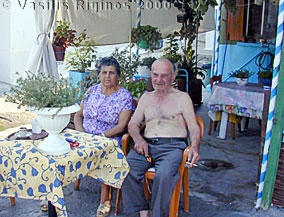
Thetis spent this time in Poseidonio while we were at our house in Kalami. There were some problems during this period.
The bottom in Poseidonio is soft mud with weeds. Many anchors drag here. And while Poseidonio is maybe the anchorage most protected from the meltemi in all of Samos, it still gets some rather violent gusts. A few days after our arrival Nikos Karapanayiotis called me and reported that the wind had shifted to the NE and Thetis seemed to have drifted very close to the land. I went to Poseidonio in a great hurry. Fortunately it was a false alarm. The second anchor (Brittany) with 80 m of scope did hold and Thetis still had over 1 m under her keel. Nevertheless, this made me nervous. So I went to the yacht-friendly chandlery owned by Nikos Tzoumakis at the main town Vathi and bought the largest fisherman’s hook anchor (τεσσαροχάλι - tessarochali) that he had. It weighs 25 kg. I replaced the Brittany with this new anchor. This type of anchor with its large flukes digs deep into the mud and penetrates all the weed. Now I felt that Thetis was much more secure.

Another problem manifested itself when I ran the motor to re-charge the batteries. There was a slow water leak from the hose at the intake of the cooling water pump (Thetis’ engine is cooled by raw sea water). The hose did look frayed. I found a replacement (now I also have a spare) but the leak persisted. Tightening all the clamps did not help. The leak appeared to be from the water pump. This I will have to watch. I also serviced the engine by changing the oil and replacing all the fuel and oil filters.
On the social front this was a busy period. First my Mother and her Georgian companion, Evelyn arrived. In the mean time, Telemachos’ condition did improve but he remained for over 3 weeks in the hospital and then stayed at his sister-in-law’s in Athens to be near the hospital.
Then our youngest daughter Corinna came with her friend Margaret. Having just graduated from Brown University, they undertook a biking tour of Europe. They flew to England where they biked for several days, then to France by ferry and after several days biking they went by train to Germany. Again more days biking then they took a train to Italy for more biking. After that they took a ferry to Greece and then came to Samos. Margaret stayed with us for a week. She was fun.
The next to arrive was my brother Nikos with Rozina and their dog Naxos. They came to Poseidonio with their magnificent traditional Greek boat the Faneromeni. Next came my youngest brother Byron with his wife Ivi. They stayed with us in Kalami. Finally, 11 relatives came from California: my cousin Nike Challoner with her son Dorian and his family and her daughter Mary Ann Lenderman and her family. They were installed in the Doryssa hotel. Most of them I had not seen for over 10 years. We had a grand party in Kalami. It was quite a gathering.
Then the departures started. First to leave was Alice with my Mother and Evelyn. Then Byron and Ivi. Then Dorian, then Corinna (who is going for a year in South Africa on a Fulbright). Nikos and Rozina were also getting ready to leave and so were Nike and Mary Ann. It was time for me and Thetis to also go too.